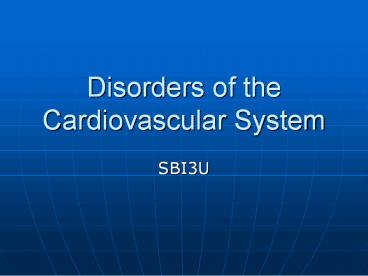Disorders%20of%20the%20Cardiovascular%20System - PowerPoint PPT Presentation
Title:
Disorders%20of%20the%20Cardiovascular%20System
Description:
SBI3U Cardiovascular disease deaths Every 7 minutes in Canada, someone dies from heart disease or stroke. Heart disease and stroke are two of the three leading causes ... – PowerPoint PPT presentation
Number of Views:211
Avg rating:3.0/5.0
Title: Disorders%20of%20the%20Cardiovascular%20System
1
Disorders of the Cardiovascular System
- SBI3U
2
Cardiovascular disease deaths
- Every 7 minutes in Canada, someone dies from
heart disease or stroke. - Heart disease and stroke are two of the three
leading causes of death in Canada.
3
What is hypertension?
- Increases blood pressure in the arteries
- Effect on the body
- Heart becomes over worked trying to pump blood
against the high pressure - Arteries damaged walls become hardened
(arteriosclerosis) and lose their elasticity - Blood clots can occur coronary artery will cause
heart attack in the brain cause a stroke - Kidneys may be damaged
4
The Risk Factors of coronary heart disease
- ?
5
- Things you cant change
- Family history
- Increasing age
- Gender
- Controllable
- High blood pressure
- Elevated blood fats
- Obesity
- Diabetes
- These you can change
- Poor eating habits
- Response to stress
- Physical inactivity
6
DISORDERS OF THE CIRCULATORY SYSTEM (Blood
Vessels)
- Arteriosclerosis
- Overtime too much pressure in arteries lead to
hardening and loss of elasticity of the arterial
wall - hardening of arteries
- Caused by hypertension, age, plaque buildup
7
Atherosclerosis
- Most common form of arteriosclerosis
- Due to plaques develop on the inner walls of the
arteries, narrowing their inner diameter - Fat cholesterol, calcium, and other materials
form plaque
8
Treating Arteriosclerosis Angioplasty
- Catheter with a balloon is inserted into femoral
artery and snaked all the way to coronary artery - Balloon is expanded and stent holds artery open
9
Angioplasty
- http//www.youtube.com/watch?vfL3Aak_PI-I
10
Heart Attack
- caused by a blockage of an artery that supplies
the heart with blood thus cutting off supply of
O2 to cardiac cells - symptoms ? indigestion
- chest pain
- pain along the left arm
11
(No Transcript)
12
HEART ATTACK (MYOCARDIAL INFARCTION)
13
Treating Arteriosclerosis Coronary Bypass
- Section of healthy artery or vein from another
part of the body (usually leg) is removed and put
in place of blocked coronary artery - Double, triple or quadruple
14
ANGINA
15
Angina treatment
- Nitroglycerin dilates coronary arteries, allowing
blood to reach cardiac muscle tissue
16
Stroke
- caused by a blockage of an artery supplying the
brain, cutting off the supply of O2 to brain
cells - symptoms vary depending on area of brain affected
17
(No Transcript)
18
Aneurysm
- occurs as a result of a broken blood vessel
causing the inner wall of the artery to bulge
19
ANEURYSMS
- Abnormal weakening in artery wall
- Pressure of the blood flowing through the vessel
creates a bulge at the weak spot - When the size of an aneurysm increases, there is
a significant risk of rupture, resulting in
severe hemorrhage, complications or death
20
HEART MURMURS
- A heart murmur is an extra or unusual sound heard
during a heartbeat - No symptoms
- Usually harmless
21
- Heart Disorders
- Murmur
- one or more of the heart valves does not open or
close properly - failure to open ? restricts flow of blood from
the heart - failure to close ? blood being drawn back into
the heart - characteristic whooshing or rasping sound caused
by the blood escaping from the valve - most common ? mitral valve (A-V valve) prolapse
22
(No Transcript)
23
- Blue Baby Syndrome
- septal defect is a hole in the septum
- allows oxygenated and deoxygenated blood to mix
in the heart
24
CONGESTIVE HEART FAILURE
- Your heart muscle cannot pump, or eject, the
blood out of the heart very well. This is called
systolic heart failure. - Your heart muscles are stiff and do not fill up
with blood easily. This is called diastolic heart
failure.
25
CONGESTIVE HEART FAILURE
- As the heart's pumping action is lost, blood may
back up in other areas of the body, causing fluid
to build up in the lungs, the liver, the
gastrointestinal tract, and the arms and legs. - As a result, there is a lack of oxygen and
nutrition to organs, which damages them and
reduces their ability to work properly.
26
ANEMIA
- Lower than normal amount of oxygen reaching
tissues due to - Low number of red blood cells
- Less hemoglobin in red blood cells than normal
- Sickle cell anemia (abnormally shaped red blood
cells)
27
Blood Disorders
- Anemia
- caused by a lack of red blood cells or hemoglobin
content
28
- Hemophilia
- blood clots slowly or not at all
- caused by a lack of one of the factors involved
in the release or activation of thromboplastin
from platelets
29
- Mononucleosis
- caused by a virus that can be transmitted by
saliva, coughs and sneezes - decrease in the ratio of red blood cells to white
blood cells ?so more white blood cells!
As many as 95 of adults between 35 and 40 years
of age have been infected
30
LEUKEMIA
- Cancer of the blood or bone marrow, where white
blood cells are overproduced - These extra white blood cells are immature or
dysfunctional, and create a harmful RBC / WBC
imbalance
31
- Leukemia
- a form of cancer that affects the organs that
form blood cells - great increase in the number of white blood cells
32
- AIDS
- (Acquired Immune Deficiency Syndrome)
- caused by a virus (HIV) that attacks the immune
system, destroying the Helper T cells, affecting
the bodys ability to fight infections































